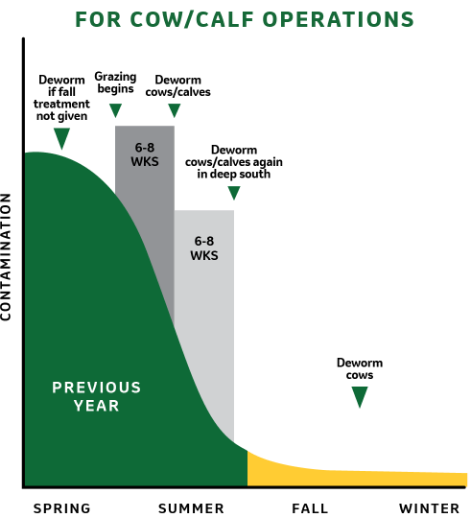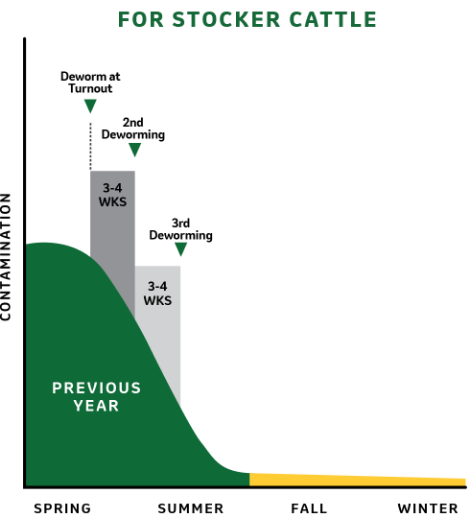Parasite control is an ongoing battle. SAFE-GUARD (fenbendazole) is ready.
When it comes to deworming cattle, choose SAFE-GUARD to help get the most from your herd. SAFE-GUARD features broad-spectrum protection against the most concerning internal parasites, including Ostertagia, Cooperia and more.
Deworming cattle to stay ahead of profit-eating parasites.
The signs of a severe parasite infection are easy to spot. But it’s important to keep an eye out for the less severe signs that can indicate the start of a problem, so you can take swift action.
SIGNS TO WATCH OUT FOR:
SAFE-GUARD is a fast-acting dewormer that goes straight to the gut, killing worms where they live.
Reduced feed intake
Increased incidence of disease
Decreased reproductive performance
Lower milk production
Keep cattle protected in the pasture.
Parasites shed by cattle last season are often the source of infection for cattle this season.
Cleaning up your pasture starts with deworming cattle to remove worms and stop egg shedding back onto the grass.
INTERNAL PARASITE LIFECYCLE
- Cattle ingest infective larvae (L3)
- Immature worms move to the gut where they mature; adult worms lay eggs
- Eggs pass through feces back onto the grass where they become larvae and continue to mature (L1, L2)
- Infective larvae (L3) are mobile and move away from manure pats to grass to be consumed
SAFE-GUARD Feed Formulations are up for the job.
All formulations of SAFE-GUARD are powered by fenbendazole. But with feed formulations, how can you be sure cattle are receiving the proper dose? It’s called the cumulative dose effect.
Fenbendazole builds up in the fat tissue of parasites.3 Even cattle that ingest small amounts of SAFE-GUARD over the course of a few feedings will quickly build up to a dose that is lethal to internal parasites.
See all the reasons why feed formulations work and work well.
The convenient way to get deworming right.
With SAFE-GUARD’s flexible feed formulations, there’s no need to run them through the chute to keep them protected from ROI-eating parasites. That makes it easier to administer an extra dose between gatherings, which may be required to break the parasite lifecycle and keep cattle clean all season long.
A veterinarian’s take.
Parasites can significantly weigh down your herd. Louisiana veterinarian Dr. Paul Whittington explains how they impact animal health and performance.
The SAFE-GUARD Guarantee.
One way you can check that your parasite management program is working is through a fecal egg count reduction test (FECRT). A FECRT will not only tell you which parasites you’re dealing with, but also if they’re responding to your program. With Safe-Guard, you can expect to see a 90% reduction in fecal egg count after just 14 days.1
Put Safe-Guard to the testDeworming Cattle: Schedule and Time Matter
When it comes to deworming cattle, schedule based on your operation type and location, as well as the parasite life cycle. Doing so reduces the parasite burden both in your herd and on the pasture.
Select your operation type to see the recommended guidelines.
COW/CALF

FALL
Deworm at the end of the grazing season or after the first killing frost in areas where cattle remain on-pasture year-round.
SPRING
If fall treatment was not given after the first frost, deworm at turnout or grass green-up – and then again 6-8 weeks later.
If fall treatment was given after the first frost, deworm the adult cow and her suckling calf 6-8 weeks after spring grazing begins.
MID-SUMMER
In warm weather regions, a second deworming given 6-8 weeks after the first spring deworming may be warranted due to high parasite populations and transmission.
STOCKER

SPRING/SUMMER
Deworm cattle at turnout, or the beginning of extended grass growth.
Follow with a second treatment 3-4 weeks later.
Finish with a third treatment three to four weeks after the second deworming.
WINTER
A deworming treatment at turnout can help provide control for the winter grazing season.
A second treatment three to four weeks later is recommended if there was a possibility of pasture contamination at turnout.
DAIRY

INDIVIDUAL STRATEGY
Dairy cows exposed to moderate or high levels of parasites or grazing pastures should receive treatment at freshening and again after 6 weeks.
SEASONAL STRATEGY
Dairy cows exposed to low levels of parasites only need to be treated at freshening or as a herd once a year, ideally in late fall.
TRANSITION GROUP STRATEGY
Transition cows have different energy needs from other cows in the milking rotation.
Treating in the first transition period will reduce internal parasite loads.
The key is to deworm the “group” on a specific day, on a regular schedule.
Nail the timing of your treatments with SAFE-GUARD’s simple scheduling tool.
Determine how much of your preferred formulation you’ll need to effectively treat your herd with the SAFE-GUARD dosage calculator.
References:
- Smith RA, et al. Pasture deworming and (or) subsequent feedlot deworming with fenbendazole. I. Effects on grazing performance, feedlot performance and carcass traits of yearling steers. The Bovine Practitioner. 2000 May 1; 34(2), 104-114.
- Safe-Guard/Panacur Deworming Strategies for Dairy Cattle. Dairy Monograph. Intervet.
- Vercruysse J, Claerebout E. Mechanisms of actions of anthelmintics.
Merck Veterinary Manual Online. https://www.merckvetmanual.com/pharmacology/anthelmintics/mechanisms-of-action-of-anthelmintics. Accessed February 2, 2021. - Intervet Safeguard Technical Bulletin Part Number A640416 2001.
- Hoechst-Roussel Agri-Vet Company Study Number A640468.
- Blagburn BL, et al. Efficacy of fenbendazole medicated feed blocks against gastrointestinal nematode infections in calves. Am J Vet Res. 1987;48(6):1017-1019.
- Blagburn BL, et al. Evaluation of three formulations of fenbendazole (10% suspension, .5% pellets and 20% premix) against nematode infections in cattle. Am J Vet Res. 1986;47(3):534-536.
- Saad MB, et al. Efficacy of Fenbendazole Against Adult Dictyocaulus viviparus in Experimentally Infect Calves. Am J Vet Res. 1977;38(9):1427-1428.
- Crowley JW, et al. Further Controlled Evaluations of Fenbendazole as a Bovine Anthelmentic. Am J Vet Res. 1977;38(5):689-692.
- Bliss DH. Comparative Evaluation of Fenbendazole (5mg/kg) administered either via a free-choice mineral or in a 10% oral suspension and ivermectin (100 or 200 mcg/kg) administered subcutaneous.
- Miller JE. Efficacy of Safeguard En-Pro-Al Molasses Deworming Supplement Blocks Against Inhibited Larvae of Ostertagia ostertagia. Southern Conference on Animal Parasites. 1989. March 26-28. Abstract #75.
- HRVET Study No 97-0020.
- Smith SJ, et al. Effects of Safeguard free choice protein blocks on trichostrongyle nematodes in pastured cattle from eastern South Dakota. Proceedings of the South Dakota Academy of Science. 2012;91.
- Williams JC, et al. Efficacy of a spring fenbendazole treatment program to reduce numbers of Ostertagia ostertagi inhibited larvae in beef stocker cattle. Vet Parasitol. 1995;59(2):127-137.
- Reinemeyer CR, et al. Larvicidal efficacy of three formulations of fenbendazole against experimentally-induced gastrointestinal nematode infections in cattle. Intervet Research Report.
- Merck Animal Health National FECRT Database.




 Go To United States
Go To United States Algeria
Algeria Argentina
Argentina Australia
Australia Austria
Austria Bahrain
Bahrain Belgium (Dutch)
Belgium (Dutch) Brazil
Brazil Canada (English)
Canada (English) Chile
Chile Colombia
Colombia Croatia
Croatia Czech Republic
Czech Republic Denmark
Denmark Ecuador
Ecuador Egypt
Egypt Finland
Finland France
France Germany
Germany Greece
Greece Hungary
Hungary India
India Indonesia
Indonesia Iraq
Iraq Ireland
Ireland Israel
Israel Italy
Italy Japan
Japan Jordan
Jordan Kuwait
Kuwait Lebanon
Lebanon Malaysia
Malaysia Mexico
Mexico Morocco
Morocco Netherlands
Netherlands New Zealand
New Zealand Norway
Norway Oman
Oman Panama
Panama Peru
Peru Philippines
Philippines Poland
Poland Portugal
Portugal Qatar
Qatar Romania
Romania Russian Federation
Russian Federation Saudi Arabia
Saudi Arabia South Africa
South Africa South Korea
South Korea Spain
Spain Sweden
Sweden Switzerland (French)
Switzerland (French) Taiwan
Taiwan Thailand
Thailand Tunisia
Tunisia Turkey
Turkey Ukraine
Ukraine United Arab Emirates
United Arab Emirates United Kingdom
United Kingdom Uruguay
Uruguay Yemen
Yemen Global
Global